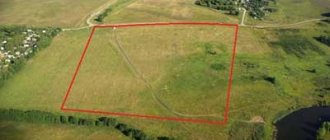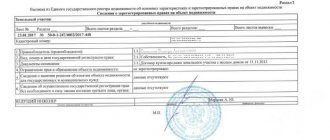What is written in the law
For many years now, work has been underway in the Russian Federation, the purpose of which is to record land boundaries, as well as record the land itself.
To simplify such large-scale work, some amendments were made to legislative acts, namely:
- In the Land Code of the Russian Federation.
- In Federal Law No. 218, called “On State Registration of Real Estate”.
- In Federal Law No. 221 “On the State Real Estate Cadastre”.
Since in practice disputes regarding the boundaries of land plots have increasingly begun to arise, in addition to amendments to regulations, the law also stipulated that each land owner must prepare a boundary plan. Already in 2021 and 2022, without such a plan, it will be impossible to register your real estate and conduct transactions with previously registered real estate if the land surveying procedure has not taken place.
What you need to know about land surveying
Demarcation of the territory is the first thing that needs to be done in order to avoid future disputes about the boundaries of the land. It is the land surveying procedure that allows the owner of each plot to legally determine their boundaries, and moreover, to secure them.
It is necessary to determine the boundaries if in the future it is planned to do the following with the site:
- divide into several separate ones;
- privatize;
- clarify its boundaries;
- obtain the necessary documents that will allow construction work to be carried out;
- obtain a cadastral passport or other documents for the plot;
- allocate land if it is in common ownership.
Before ordering a survey, you need to make sure that you have the following package of documents on hand:
- Identity card (passport).
- Cadastral document for the plot.
- Documents indicating the existence of land ownership.
- Extract from the Unified State Register of Real Estate.
It is worth knowing that only the owner of the site has the right to order a land surveying procedure. The person who leased the land does not have such a right.
Land disputes
Very often, conflicts arise between neighbors of two plots of land due to the fact that they cannot accurately determine the boundaries of their lands. If the dispute cannot be resolved peacefully, then it is best for both owners of adjacent plots to go to court. This is the only way to save your personal money and time.
ATTENTION !!! As statistics show, land disputes are considered one of the most complex on the territory of the Russian Federation. This is explained by the fact that at the legislative level this area does not yet function entirely correctly. And that is why disputes over the boundaries of the land can last for more than a year.
Every owner of a plot of land should know that he can protect himself from possible conflicts with neighbors, but only if he follows these recommendations:
- carefully review the documents provided by the engineer after carrying out cadastral work. It is at this stage that problems very often arise, and they can be resolved in time;
- in the event that the boundaries of the land plot were determined a long time ago, then it is best to make a new request to remove the boundaries in order to personally determine for yourself whether the current boundaries correspond to the previously defined ones.
First of all, if a conflict arises with neighbors, you should make sure that you are right, and only then contact a judicial authority.
How to properly file a complaint against a neighbor on a plot of land
complaints about neighbors on a land plot to the Administration for free in word format
In modern life, where everyone is trying to earn capital in every possible way, neighborly disputes over a plot of land turn into “a small war for meters, peace and quiet.
Among the causes of disputes and conflicts between neighbors on land plots, the following are identified: violation of plot boundaries, noise, drunken screams at any time of the day, flooding of the plot and other incidents.
A normal, law-abiding citizen, when the right to use a land plot is infringed, be it a garden plot or a personal plot near the house where he lives, questions arise: what to do in this situation, where to go, how to protect his land plot and stop the illegal actions of his neighbors, etc. . P.
One way to influence neighbors is to contact the local administration. This method is a legacy of our country’s Soviet past. When the administration of a city or district had a stronger position compared to the present situation, including in resolving land issues.
An application or appeal is drawn up in any form, and there are a number of requirements, compliance with which is mandatory.
Can a land plot that is owned be seized?
Public form of ownership of a land plot - what it is, read here.
How to draw up a statement of claim to the court on land issues, read the link: https://novocom.org/dokumenty/iskovye-zayavleniya/obrazcy-iskovyx-zayavlenij-v-sud-po-zemelnym-voprosam.html
The complaint must indicate:
- the body to which complaints are submitted,
- position, full name of the head of the government body (posted on the official website),
- The applicant’s full name, residential address, telephone number and other contact information if necessary and available,
- name of the complaint (will be indicated as “Complaint”),
- Next comes the text of the appeal, which reveals the essence of the conflict: what happened, when, with whose participation, indicating documents or citizens confirming what was written. It is advisable to indicate in the complaint the reasons for the conflict and the appeal to government agencies, and to describe the parties’ attempts to resolve the situation without contacting government agencies. When finishing your presentation of what happened, indicate the violation of the law by the unlawful actions of your neighbors.
In conclusion, we ask you to resolve the current situation and take measures to protect the rights of the applicant.
Then - a list of documents confirming what happened, then the signature and date of preparation.
How to rent land from the city administration?
The most common causes of disputes
Against the backdrop of constant conflicts between the owners of adjacent plots, standard prerequisites were established by which it can be determined that the dispute will go into court proceedings.
As a rule, this happens if:
- Errors were found in the real estate documents, which were also entered into the Unified State Register of Real Estate. This may mean that the boundaries of the plots were superimposed on each other.
- The cadastral engineer made incorrect calculations when taking measurements. It is worth noting that you can prove the engineer’s mistake only if you order another survey procedure.
- Independent seizure of someone else's territory. In case of squatting, neighbors, as a rule, without any legal grounds, move the fence to someone else's land. This leads to a decrease in the territory of the other owner, and moreover, this happens illegally. In such a situation, it is important to try to talk to your neighbors. But if they do not agree to a peaceful solution to the problem, then it is worth bringing the court to trial. If the judicial authority rules in favor of the plaintiff, the borders will be restored.
With the onset of 2021, and in 2022 as well, the land surveying procedure must necessarily be agreed upon with the owners of adjacent plots. If the rights of neighbors were not taken into account during the land surveying process, then the result of the procedure may be considered invalid, even if they are already included in the Unified State Register of Real Estate.
Practice of resolving disputes with neighbors arising during land surveying
- last names, first names, patronymics of all persons, if they are considered interested;
- details that will prove your identity;
- agreeing on the location of boundaries;
- diagrams of all points that indicate boundaries;
- claims of participants (if any);
- seal and signature of the engineer drawing up the act;
- signatures of all participating persons.
- It is possible to increase the size of a land plot legally. For example, if one area is specified in the documents, but in practice it does not correspond to those indicated due to the squatting of part of your plot by neighbors. In this case, land surveying is a way to restore justice and regain your lands.
- You will be able to correctly plan all the buildings on your site, which are regulated by regulations. For example, the distance from the building to a residential building must be at least five meters, and if we talk about outbuildings, then the distance between them must be at least three meters.
- If there are several owners, then the consequences of land surveying may be the distribution of clear boundaries for each of them.
We recommend reading: Queue of heirs by law
How to start resolving disputes
As already mentioned, when conflicts arise with neighbors, first of all it is worth trying to solve the problem peacefully.
And only if this fails, then you should proceed to the following steps:
- If an error is identified in the Unified State Register, you must send an application to Rosreestr and ask for it to be corrected. In addition to the application, you must attach documents to it that can confirm the presence of an error. As a rule, after three days, Rosreestr employees will make a decision: they will correct the error or refuse it, since all the information specified in the Unified State Register will be reliable.
- Clarify your boundaries in relation to adjacent areas. This is the only way to prove your rights in court. Also, the presence of accurate data on the boundaries of plots can, in some situations, convince other neighbors of the reliability of the data, and then there will be no need to go to court at all. To determine the exact boundaries of the territory, it is necessary to invite a cadastral engineer. After cadastral work is carried out, an approval act is drawn up, which must be signed by the owners of adjacent plots. It is worth noting that before carrying out the land surveying procedure, it is necessary to tell those interested in resolving the dispute about this at least 7 days before the procedure itself.
IMPORTANT !!! In the event that one of the neighbors cannot be present during the cadastral work, then the engineer himself is allowed to sign the agreement. If, however, the neighbors did not show up for the land survey after the notification, then, as prescribed by law, the act of approval can be approved without their signature. As Federal Law No. 218 states, namely its 43rd article, if one of the owners of adjacent plots does not agree to agree on the boundaries of the plot, the resolution of the issue is referred to the court. After one of the neighbors refuses to clarify the boundaries, a statement of claim is attached to the agreement.
Disputes about land boundaries
Observations of judicial practice related to disputes over land plots show that their legs often grow, so to speak, from the “border issue”. I would like to share some thoughts and conclusions made on the basis of a comparison of the current legislation (not always clear enough) on the appropriate methods of protection in the event that, according to the state real estate cadastre, the boundaries of two (or more) land plots intersect with each other (i.e. place where land plots overlap each other). I decided to bring these thoughts (long overdue) to the public and to the judgment of my colleagues in connection with the consideration by the Presidium of the Supreme Arbitration Court of the Russian Federation of case 8410/13, and an open topic here. I apologize to the author, but due to the volume of the text, I considered it more appropriate to publish it independently.
Currently, often land plots, despite the fact that they are registered in the cadastral register and the rights to them belong to certain persons, and this is even confirmed by registration in the Unified State Register, do not have a proper description of their boundaries, cross their boundaries or even completely overlap other plots . According to data presented at the Presidium of the State Council in October 2012, up to half of the land plots do not have a proper description of boundaries.
It must be said that this problem, in general terms, is largely predetermined historically, including by the method of reforming the system of cadastral description and registration of rights to land plots, which was adopted in our country.
Specific methods of describing and establishing the boundaries of land plots for the purpose of legally fixing them as objects of civil rights largely depend on the achievements of science and technology (i.e. this is largely a technical issue) and the adopted system for recording objects and rights to them, whether local or centralized , declarative or inventory nature, etc. The reform carried out in our state in this area since the 70s of the 20th century. consists of consolidating information about all land plots created at different times, during the period of validity of various legislation, using various methods of determining boundaries, including various local coordinate systems, and sometimes without using them, into a single system of the state real estate cadastre. Of course, this is only possible by bringing all available information about the boundaries of land plots to a single denominator and filling in the missing data. A characteristic feature of this reform is that the construction of the real estate cadastre in general, as well as in terms of clarifying and completing missing information, eliminating contradictions in information about land plots, is based on the declarative principle. The legislator has practically abandoned the inventory of information on land plots previously provided for by the legislation on land management.
The described general direction of development of legislation on cadastral registration of land plots is manifested in the provisions of the current legislation on cadastral registration. Knowledge of these provisions and, most importantly, the ability to isolate the meaning from them allows one to overcome the dissonance that arises in the lawyer’s head between the doctrinal understanding of a land plot, its legislative definition (Article 11.1 of the Land Code of the Russian Federation) and the realities of everyday life, where land plots “without borders” are encountered at every step "
The Law on the State Property Committee recognizes all land plots created before 03/01/2008 (the date of entry into force of this law) as previously registered (i.e., existing) and in the absence of information about them in the State Property Committee (Article 45 of the Law on the State Property Committee). For these land plots, a special procedure is provided for entering information about them into the State Property Committee, which differs from the cadastral registration of newly formed land plots - entering information about previously registered real estate objects (Part 1 of Article 16, Parts 3, 6, 7 of Article 45 of the Law on the State Property Committee , paragraphs 18, 21 of the Procedure for maintaining the state real estate cadastre, approved by order of the Ministry of Economic Development of Russia dated February 4, 2010 No. 42). The peculiarity of this procedure is that:
(1) it can be carried out either on the initiative of the cadastral authority in order to inventory information about objects of rights registered in the Unified State Register, or on the initiative of a person who considers himself the owner of the right to the relevant plot and confirms this right with written evidence issued during the period of formation (allocation) and provision of a land plot (clause 21 of the Procedure for maintaining the state real estate cadastre, approved by order of the Ministry of Economic Development of Russia dated 02/04/2010 No. 42, note 4 to column 6 “Date of entering the number in the State Property Committee” of the land plot cadastral passport form, approved by order of the Ministry of Economic Development of Russia dated 12/28/2012 No. 831);
(2) information about a previously registered land plot is entered into the State Property Committee “as is”, i.e. without carrying out a new survey and clarifying data on the boundaries of the site, without preparing a boundary plan (clause 2 of part 1 of article 22 of the Law on the State Property Committee).
Often, however, in violation of the stated rules, a previously registered plot, instead of entering information about it into the State Property Committee and subsequent clarification of its boundaries, was put on the cadastral register anew, as a newly formed one, or a new land plot was put on the cadastral register, essentially formed from the previously registered one, but without designation of this and without observing the rules of cadastral registration when creating land plots (Chapter 1.1 of the Land Code of the Russian Federation, Articles 24, 25 of the Law on the State Property Committee). For example, instead of transforming a previously registered land plot in respect of which there is a previously arisen right of permanent (perpetual) use, the owner of the real estate located on it puts on cadastral registration the plot formed in the manner prescribed by paragraph 7 of Article 36 of the Land Code of the Russian Federation. As a result, it is quite common for the same plot to be registered twice or to be part of itself. This is revealed, as a rule, in cases where information about a previously registered plot is entered into the cadastre later, by another person, etc., but it may never be detected. If, when entering information about a previously registered plot, its boundaries are simultaneously clarified, from the point of view of the result (the appearance in the real estate cadastre of information about a land plot with established boundaries), the line between the procedures for registering a plot as a new one for cadastral registration and entering information about it as previously registered practically erased. Those violations of public interests (preserving the continuity of the history of transformations of real estate objects) and neighbors (establishing boundaries without agreement with adjacent rights holders), which occur with such a substitution of procedures, obviously can be eliminated without canceling the cadastral registration of the site (correcting a cadastral error, resolving a dispute about boundaries with a neighbor).
(3) the legislator does not force rights holders to clarify the boundaries of the plots they own (the declarative principle), but encourages them to do so by establishing a ban on conducting cadastral registration, issuing a cadastral passport and registering rights in relation to land plots whose boundaries are not specified, i.e. . when there is no information about the boundaries of the site in the State Property Committee or the site intersects with the boundaries of other sites (parts 3, 4 of Article 14, paragraph 2 of part 2 of Article 26 of the Law on the State Property Committee, Article 19 of the Federal Law “On Registration of Rights to Real Estate and Transactions with It”) .
(4) clarification of information about the boundaries and area (ordering of boundaries) of previously registered plots is carried out at the request of the copyright holder with mandatory land surveying, during which the boundaries of the surveyed plot must be agreed upon (recognized) by the copyright holders of adjacent land plots (parts 3, 3.1 of Article 25, part 3, Article 38, Articles 39, 40 of the Law on the Civil Code);
(5) if the owner of the adjacent plot does not agree with the proposed description of the boundary separating his plot from the adjacent one (adjacent boundary), clarification of the State Property Committee data on the boundaries of the plots is possible only after the court resolves the relevant dispute, i.e. a dispute about the location of an adjacent border (border dispute, boundary dispute) (clause 2 of part 1 of article 22, clause 9 of part 3, clause 2 of part 5 of article 27 of the Law on the Civil Code).
Depending on the situation, two categories of such disputes can be distinguished:
1) There is no dispute about the actual location of the adjacent border.
This situation usually occurs when there is a so-called cadastral error in the description of one or the other or all adjacent plots (Article 28 of the Law on the State Property Committee), i.e. essentially unreliable cadastral information about land plots. The unreliability (incorrect reflection on the site plan of its virtually indisputable border) of this information can be caused both, indeed, by errors of the cadastral engineer, land surveyor, and by the incomparability of data (different coordinate systems, measurement methods, errors, etc.) about the boundaries of adjacent sites . In this case, the task of the cadastral engineer and the court (if the adjacent owner does not want to change the information about his site) is to determine the actual boundary indicated by the parties on the ground, put it on the boundary plan and enter information about it into the State Property Committee.
2) There is a dispute about the actual location of the border, i.e. several persons claim the same part of the earth's surface, believing that it belongs to different land plots belonging to them (A believes that this part belongs to plot A, B believes that it belongs to plot B). Most often, such a situation arises when, in the absence of information about the boundaries of previously registered land plots on the cadastral plan of the territory (duty cadastral map), a local government body (another public legal entity) considers a particular territory as free and forms a land plot at its expense and provides it to one person or another. Since in this case, there is essentially a “seizure of part of a land plot belonging to another person,” alienation by an unauthorized person of part of one plot as part of another plot, the dispute about the location of the border should, it seems, be considered as a dispute about the right, but with some differences :
- this is not a dispute about the right to a specific piece of real estate, but a dispute about the right in relation to only the disputed part of the land surface (a dispute about which of the adjacent plots this part rightfully belongs to);
— the result of resolving such a dispute should not be the exclusion of the entry on the right from the Unified State Register (unless there is a complete overlap of plots with each other or one plot is not located completely within the boundaries of the other), but a change in information about the location of the adjacent border of two plots in the State Property Committee (information on the boundaries and area of the relevant areas);
- the court, as in the framework of a dispute about the right to a specific object, may come to the conclusion that possession of the disputed part of the land surface has been lost by the plaintiff, that the statute of limitations has expired, or the defendant is a bona fide purchaser, which, unlike a dispute about the right to an independent piece of real estate, should entail not a refusal of vindication, but the establishment of a boundary in accordance with how it is indicated by the defendant.
In any case, as follows from the above, a dispute about the boundaries of land plots is a dispute aimed at protecting the right to a land plot (it is in this sense that the provision of paragraph 2 of the resolution of the Plenum of the Armed Forces of the Russian Federation and the Plenum of the Supreme Arbitration Court of the Russian Federation No. 10/22 of April 29, 2010 should be understood “On some issues that arise in judicial practice when resolving disputes related to the protection of property rights and other real rights” and paragraph 1 of the Resolution of the Plenum of the Supreme Arbitration Court of the Russian Federation dated October 12, 2006 No. 54 “On some issues of jurisdiction of cases on claims for rights to real estate” that claims for rights to real estate include claims for establishing the boundaries of a land plot). For this reason, when considering this type of dispute, the explanations contained in paragraphs 52, 53, 56 of the resolution of the Plenum of the Supreme Arbitration Court of the Russian Federation and the Plenum of the Supreme Arbitration Court of the Russian Federation No. 10/22 dated April 29, 2010 “On some issues arising in judicial practice when resolving disputes related to the protection of property rights and other property rights” with the only modification that we will be talking about updating not the Unified State Register, but the State Tax Code (the Unified State Register data are adjusted automatically when the State Property Register data about the object is adjusted), and not about the body carrying out state registration of rights , but about the cadastral authority.
Hence:
- a claim aimed at establishing a boundary or challenging the legality of establishing a boundary or, in general, cadastral registration of an adjacent (intersecting) plot must be considered in a lawsuit and the defendant in such a claim is the owner of the adjacent (intersecting) plot;
- if the actions of the cadastral authority during the cadastral procedure did not comply with the requirements of the law, they may be considered illegal (for example, a claim for compensation for damage is subsequently expected), but this cannot lead to any changes in the information about the adjacent (intersecting) land plot, those. within the framework of applying paragraph 3 of part 4 of Article 201 of the Arbitration Procedure Code of the Russian Federation, the court cannot oblige the cadastral authority to make appropriate changes to the Civil Code, including canceling information about the cadastral registration of the site;
— the border dispute is won by the one who proves his right to the “disputed part”
How will a neighbor who squatted be punished?
If the owner of a land plot has identified the fact of illegal seizure of land, he has the right to contact a land inspector, who, after the appeal, arrives at the site where a violation of the owner’s rights was discovered. Upon arrival, the inspector carries out an inspection and draws up a corresponding protocol. If a violation has indeed been identified, then the occupier of the territory is issued an order, which states that within a certain period of time he must remove his illegal buildings on someone else’s land, and also pay a fine of 1,000 rubles.
What documents need to be prepared to resolve a dispute in court?
As the Code of Civil Procedure of the Russian Federation states, namely its Article 132, a claim filed in court must be supported by relevant documents.
As a rule, the annexes to the statement of claim are:
- papers indicating the right to own the site;
- boundary plan;
- an extract from the register about a neighboring plot with the owner of which a dispute has arisen;
- receipt for payment of state duty;
- other papers that may influence the court's decision in favor of the applicant.
If the plaintiff, when going to court, does not have a boundary plan in hand, then it is allowed to present a more detailed extract from the register instead. But if the court considers the absence of a land survey plan to be unacceptable for resolving the issue, then the hearing is postponed until a land survey plan is provided.
How to resolve a land dispute between neighbors: step-by-step instructions
Before the conflict comes to court, the parties (or at least one of them) try with all their might to resolve it on their own. Sometimes this does not make any sense and it is better to immediately start preparing a claim, but in some cases you can achieve protection of your rights without going to trial.
1. Determining your position and causes of the conflict
Understand what your or your neighbor's complaint is and what it involves. If there is an error in the documentation, request the correct document, if possible. A cadastral error, for example, cannot be corrected with a simple request - you will still have to go to court.
In cases where the cause of the conflict is personal interest or “working on principle,” take an interest in legal information and first consult with a lawyer. Ideally, a written opinion from a lawyer. If the subject of dispute is only the boundaries of the site, conduct a joint survey that will help establish or restore them.
2. Sit down at the negotiating table
It is better to start resolving any conflict with negotiations. Abstract from emotions and try to calmly, without swearing, talk about the causes of the problem and options for solving it. Explain to your neighbor that escalating the conflict and bringing it to court is fraught not only with significant expenditure of time and money, but also with a not always predictable result. Provide your lawyer's arguments as support.
3. Involve the municipality in resolving the dispute
Each municipality has a number of different departments and commissions that can help resolve the dispute.
For example, the administrative commission monitors the implementation of regional laws, landscaping rules and other norms, and therefore can hold a neighbor accountable for any violations - for example, storing building materials on the boundary of the plot in front of the neighbor's house.
The land department of the city government (the department itself and the positions of its employees may have different names), responsible for considering complaints from citizens on land management issues, can give a written opinion on your appeal regarding the conflict.
Almost always, specialists will go to the site, inspect problem areas and give their recommendations for resolving the dispute.
Alas, unlike a court decision, even the conclusion of municipal authorities based on the law is not unconditionally binding on the conflicting neighbor. If all else fails, get ready for trial!
How does the trial take place?
Both the plaintiff himself and his lawyer can be present at the court hearing, with whom he must first enter into an appropriate agreement. As the Code of Civil Procedure of the Russian Federation states, namely its Article 30, to resolve land disputes it is necessary to contact the territorial judicial body. That is, you need to send the claim to the court, which is located at the location of the land plot.
ATTENTION !!! After consideration of the issue by the judicial authority, if the plaintiff’s requests are satisfied, that is, a positive decision is made in his favor, then it comes into effect within one month. During these 30 days, the defendant has the right to appeal to a higher authority and even to the Supreme Court of the Russian Federation.
As Federal Law No. 218 states, namely Articles 14 and 61, the court decision is transferred to Rosreestr. As a rule, the court demands Rosreestr to either correct existing errors or register the property. In order not to wait until the court sends the relevant document to Rosreestr, you can take a copy of the document certified by the court and hand it over to the Rosreestr department in person.
Customer Reviews
Letter of thanks
Thanks to Stepanov D.Yu. I express my deep gratitude to lawyer Denis Yuryevich Stepanov for his high professionalism and attentiveness to his case when considering the issue in word with a contractor who improperly completed the work of erecting a screw foundation. The cost of the work amounted to 178,300 rubles. And the court of the Vyborg district (Case No. 2-1432/2018) dated March 12, 2018) to collect, taking into account all fines, 504,800 rubles. Once again, I thank you and wish you success in your future work and only successful business conduct.
Grateful to you, your client. 05/18/18
Gratitude from Loseva S.I. I express my deep gratitude to Sergei Vyacheslavovich (lawyer of the firm) for his very clear, accessible help in solving my problem (protecting rights as a consumer). This is the second time I have contacted you to solve my problems. Always everything......and in full.
With gratitude, Svetlana Ivanovna Loseva, 02/15/2019
Review by G.N. Antropova To the lawyer of the Legal Agency of St. Petersburg A.V. Ermakov
I express my gratitude to you for your professionalism in protecting my interests in a criminal case, Andrey Valerievich, allow me to express my gratitude to you for your help and support. I note your high professionalism and skillful actions in defending my positions.
Best regards, G.N. Antropov
Gratitude from gr. Kolesnikova A.N. Let me express my deep gratitude to the Legal Agency of St. Petersburg, located at Spassky Lane, 12. For their professional and friendly assistance in resolving my issue! I wish to continue working, bringing benefit to all residents of St. Petersburg. And not only.
Kolesnikov Alexander Nikolaevich.
Position: Head of the Metro Implementation Sector
PS: Before your company, I contacted 5 companies on this issue and received unclear answers.
Gratitude from Vraveevsky S.A. Sergey Vyacheslavovich! Thank you very much for the consultation! All the details were disclosed to me in detail, all questions were answered comprehensively. I am very glad to receive help from a qualified specialist!
Vraveevsky S.A. 12/18/2018
Gratitude from Ustinova T.M. I would like to express my deep gratitude to Sergei Vyacheslavovich for the legal services provided when I had a difficult relationship with Beauty Salon LLC and Alfa-Bank.
Ustinova T.M. November 10, 2018
Thanks to Kavaliauskas V.A. I would like to express my deep gratitude to Vasily Anatolyevich, an employee of your company, for his enormous support and competent defense of my case. And also for having a good attitude towards people. I will recommend your organization to all my friends and family.
I wish you success and prosperity,
05/14/2018
Gratitude to the team I express my gratitude to the legal team. department of St. Petersburg. for the service provided in terminating the loan agreement for the purchase of space. funds that I had the imprudence to enter into with one of the unscrupulous companies. The lawyers responded quickly, paid a visit to the company and filmed it. Once again I express my endless gratitude and wish you continued prosperity.
Gratitude to Kavalyauskas V.A. from Astafieva A.S. I express my gratitude to the Legal Agency and in particular to lawyer Vasily Anatolyevich Kavaliauskas for the skillfully done work. Vasily Anatolyevich advised and prepared all the documents necessary for court proceedings. As a result of the consideration of the consumer rights case, the result and the high amount exceeded all my expectations. Thank you very much for your qualified work and professionalism.
Sincerely, Astafieva A.S., 03/01/2019









